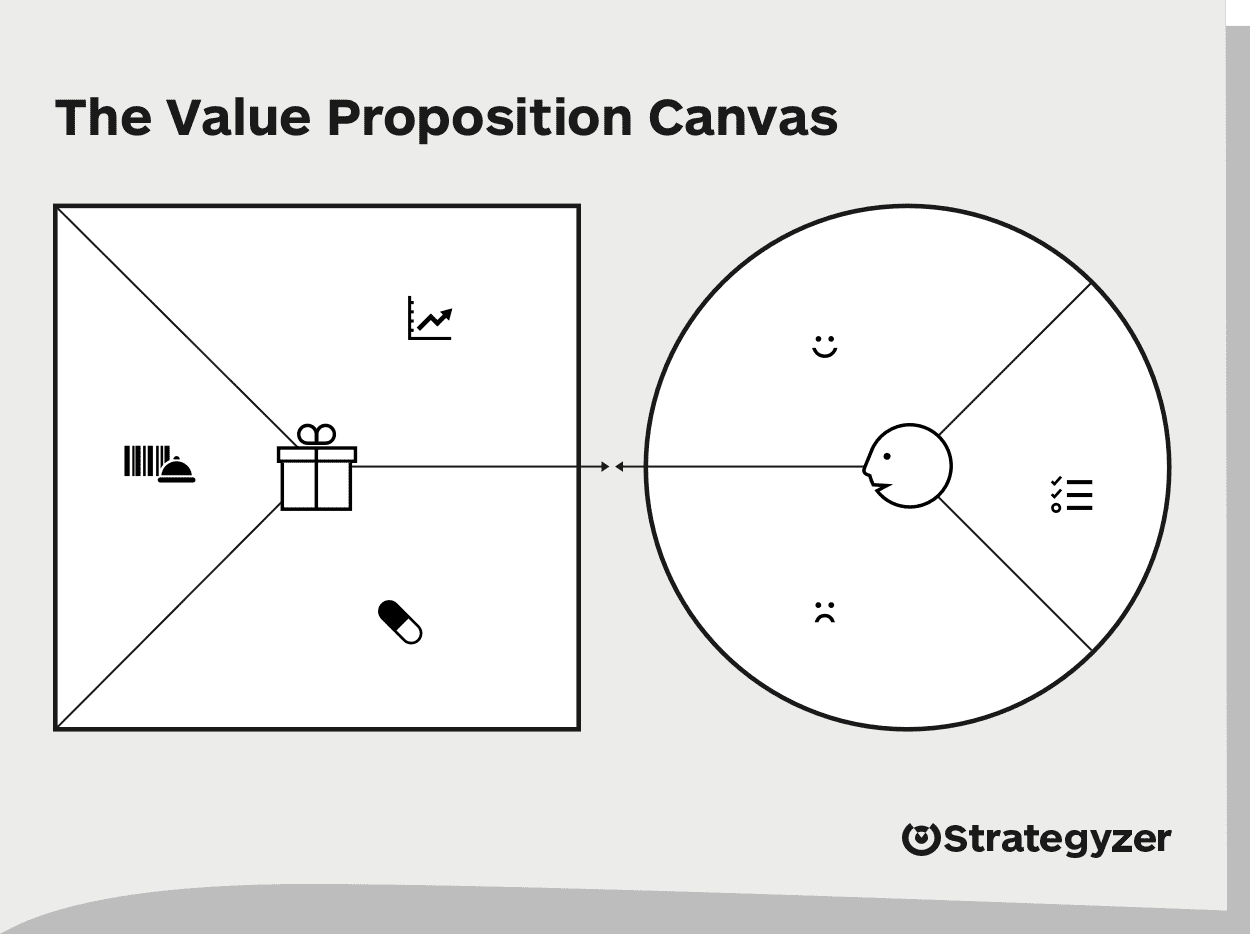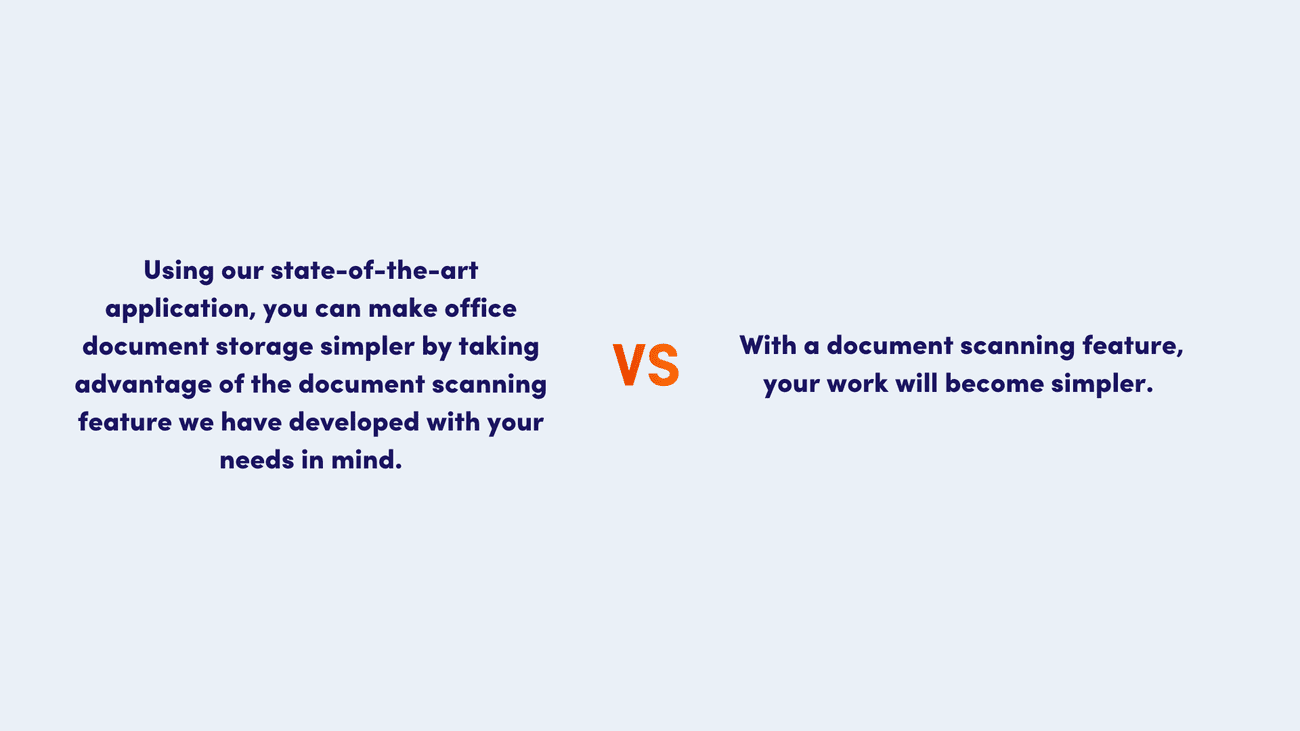Software (SaaS) value proposition
The essence of business is to provide value to customers so that they can get rid of obstacles in their daily lives and achieve their goals. In a highly competitive world where SaaS solutions are the order of the day, companies that deliver a great value proposition to their users win.
By creating a strong value proposition that your audience expects and needs all at once, you can build a competitive advantage that will differentiate your business and show potential customers your solution is worth using regularly.
From this article, you will learn how to build a true value proposition for your SaaS product to attract customers and make them see the right benefits.
What is a value proposition?
Every SaaS company should focus on building value in the eyes of the customer through what is important to the target group. People buy emotionally, through the lens of what they will get out of that purchase.
That's why for SaaS companies, many times even the most competitive pricing can't compare to a well-thought-out and properly communicated value proposition.
This is something that represents nothing but the essence of what your organization can do for your target customer, and why they should choose you. In practice, it's a short, powerful statement that shows what value your SaaS product brings to the buyer's life. It tells them how it solves their problems.
The concept of value proposition itself is not new. In 1988, Michal J. Lanning and Edward G. Michaels first named the approach in their report for McKinsey. You can find a link to the detailed report here.
The concept is not to be mistaken with a selling point, we have an article on the difference between USP and UVP.
Proposition examples you should check
There are a lot of different value propositions on the market, but you should get inspired by businesses that do it in the right way. Below you'll find good examples that have been well-thought-out and get at the idea of building value well.
Slack
Some would argue that everyone working in IT needs to know about this solution. Apparently, the world is divided into those who already use this tool and those who simply haven't discovered it yet.
Slack is a very practical and well recognized messaging app in the online space. The solution that increases productivity and at the same time makes cooperation between people more enjoyable has gained countless fans across the globe. This is because, from the beginning, the creators of this service wanted to make sure the value proposition includes the needs of customers and considers their pain points.
Slack's message is clear. It's a solution that your team members can recognize as a digital HQ. The complexity of the solution means that they can be more organized and have better work outcomes. It's a value proposition that takes on special importance in today's fast-paced economical environment.
If by some miracle you are not familiar with Slack, visit their website: slack.com
Evernote
Have you ever wondered what tool you should use to keep your work and personal life well organized? The answer to this question might be Evernote – a cloud-based application that provides you with a reliable and powerful note-taking system. This is a great example of where a company's value propositions are heavily emphasized on its website and throughout the company's communications.
The strong message we can see already at the top of the company's website is "Remember everything", which clearly hits the problem of loss of control that often occurs in unorganized people. The statement goes on to make it clear that you can achieve this state by using notes and tasks. And you can organize it all in one place. The various functionalities highlighted by Evernote clearly focus on eliminating the problem of disorganization. They make your work faster and more enjoyable.
If you haven't used Evernote yet, make sure to check evernote.com
Google Drive
Today, it is hard to imagine someone who has never used, or at least heard of a solution from one of the world's most famous organizations. Google Drive is an integral part of the work of millions of companies around the world, which appreciate not only its attractive price, but also its purely practical dimension.
The value that the giant from California gives to users at different stages of their tasks can be seen not only in the work with the tool itself, but also in the company's daily communication. Already on their landing page, we can find information about how versatile and at the same time universal the disk is. Giving users the possibility to use one common place through different devices, the company focuses on making work as comfortable as possible.
Google's value propositions not only respond to the needs, but also in a very simple and specific way relate to specific groups of recipients, namely people who in their work appreciate practical and flexible business tools.
In addition to practicality, Google points out other important elements, such as security from online threats or the ability to integrate the tool with other products. It thus becomes the number one choice for businesses looking for flexibility and peace of mind.
To check how powerful and practical this solution is, visit https://www.google.com/intl/en/drive/
What's the role of value propositions in SaaS?
In the SaaS environment, there are plenty of startups that are trying to solve many everyday problems and fight different challenges. From accounting solutions to applications that allow you to monitor various things such as home budget, health, or commercial development.
Nowadays, you can outsource almost everything, from increasing business satisfaction to saving costs or shortening the logistics process in the company. No matter what industry the SaaS solution is in, its goal is to deal with obstacles that are important.
Lots of SaaS solutions have similar offerings which makes it hard to decide what customers should choose. A value proposition is something that helps differentiate your SaaS business from others. Something that lets your target audience know that if they want to achieve certain goals, your solution is the right choice. The role of a properly chosen value proposition is to show customers:
- how your business can help them achieve their goals
- how your app will remove their most pressing problems
- how implementing your solution translates into an experience that no one else can give them
Why is demonstrating this value so critical? It is because customers think through the lens of what they will get out of using your service. A good SaaS value proposition:
1. Allows you to attract new customers
By using value messaging in your communications, you give potential buyers a clear signal that you are giving them what they want. You can use this information not only on your website, but also in other channels such as your blog, social media, internal customer messages, or direct conversations with users.
2. Differentiates your solution from your competitors' offerings.
They say, “Stand out or die”. In business, this is one of the basic truths. Properly prepared value proposition causes the customers to perceive your solution as something unique, clearly distinguishing on the market. You can thus not only gain their attention, but also strongly emphasize the effectiveness of your business in an interesting way.
3. Gives you the opportunity to attract more leads who have the same needs.
Knowing that all people in your target audience have the same needs means you can better tailor your application to your customers' context and therefore increase their satisfaction.
This obviously translates into business results. You can create more consistent inbound marketing, thus gaining faster results related to new customer acquisition. What's more, you can also better measure the effects of your marketing efforts.
4. Increases customer retention.
When people begin to see the value proposition reflected in their experience with your app, you will build a community of engaged, loyal users who will not only use the solution regularly.
How to create a great value proposition that is really different?
Just like building a company, creating a value proposition is not an easy thing to do, although it is simple. A good proposition focuses not on selling, but on the value the customer expects. While creating this significant part of your business, you should consider several important points.
1. Be clear & precise
Too often, SaaS business founders use heavily generic wording that doesn't resonate with their audience. The more precise and clear you can be about the value you offer, the more certain your communications will resonate with a buyer who is willing to pay for a solution to their problem. It's also worth remembering that your message can be spoiled if you use overly technical jargon. In this case, the information, being incomprehensible, will simply not appeal to the emotions of customers.
As an example, we can take Evernote - an app for creating, organizing, and storing notes. In its communication, the company presents values that support entrepreneurs in organizing their work, and thus affect their effectiveness.
Right on the first page of the landing page, we can see the information that using the application you can remember about everything, all thanks to the notes and tasks that you can keep in one place. In the further part of the page, Evernote precisely describes what the customer can do and what effect they get.
2. Know who you're talking to
In the business world, a fundamental part of the strategy involved in building a value proposition is understanding the segment the solution is targeting. You can't be all things to all people. Otherwise, you become worthless. Your customers need to feel that the product was created with their world, challenges, and expectations in mind. So, you need to focus on the right people with the appropriate problems you're going to solve.
3. Focus on what's important
Your customers have their problems and are willing to put their money on whoever responds to their needs. Good communication is focused on specific challenges and shows how you can overcome those obstacles.
It's worth going back to the example of Evernote, whose value proposition shows that by organizing our work well, we can avoid a very common problem of losing control over our tasks. At the same time, by using the document scanning feature, we can avoid storing countless unnecessary documents.
4. Be good at numbers
Creating good content for a website undoubtedly involves understanding the customer. To get a good grasp of what your users really care about, learn to observe key metrics that will allow you to pinpoint what these people are really doing, and what is important to them. Having solid data in your app and drawing conclusions from it is more valuable than acting on assumptions.
5. Invoke a desire
The best SaaS value propositions invoke a desire in the customer to test the solution. In other words, they give him a strong promise of a specific outcome, which prompts him to take action. As you can see, Evernote promises you that no matter which of these three outcomes you expect, they have the right plan for you.
6. Show your uniqueness
Features in your app are not enough. Potential customers expect benefits that address needs in the authentic and individual way. The more your SaaS shows that you approach problems in an out-of-the-box way, the more it will gain in the eyes of your customers as a constantly evolving company.
If you want to prepare a compelling value proposition for your service and build your own value strategy, you can use a ready-made model – a value proposition canvas. It is a efficient methodology and a cost effective tool that will lead you step by step through the value creation process.
What mistakes should SaaS companies avoid when creating a value proposition in SaaS?
When building a value proposition for your application, you can make some mistakes that can affect the outcome. Therefore, you should keep in mind the following:
Don't copy your competitors
One of the common mistakes is to take an unreflective approach to creating services and communications based on what your competitors have already created. If you copy other companies' communications, your solution will never gain a unique position in the market.
Don't emphasize problems that are of little importance
Your organization may be solving several customer problems. However, it is worth remembering that not all concerns are of equal importance. So think about which of these challenges are important enough for customers to see the value they are interested in.
Don't invent customers for pain points
Usually, entrepreneurs are quite attached to their ideas. Unfortunately, quite often, companies rely solely on their assumptions about what customers struggle with. It makes them look for market validation of their expectations instead of creating a customized proposal. This in turn can lead to mismatched communication and negatively impact product development or sales.
Avoid complicated language
Many companies think that using specialized jargon will put them in a better position. That they will sound like professionals. Meanwhile, unless your SaaS is aimed at a small group of customers who understand a specialized language, using buzzwords can only cause unnecessary chaos. In the previously mentioned example from Slack, you can see that in its messaging the company clearly uses a simple and clear message of value for teams.
Don't drag out the length of your content
In today's world, few people have enough time to read lengthy content describing why they should use your proposition the first time they contact your company. A good value proposition should be concise and to the point.
How to check if the value proposition you created makes sense?
Your company offers solutions that help customers change their world for the better, and you've created a solidly thought-out SaaS value proposition. Now what?
Now it makes sense to test whether your vision aligns with what matters to your audience. To make sure what you've come up with is valuable, you can use some proven methods:
Use the power of a landing page
One of the best ways to confirm your hypothesis is to put your SaaS value proposition on display and see how customers react. To do so, you can create a landing page that includes a simple value statement and a CTA button (Call To Action).
There are various platforms and tools available where you can build your page. For example, Wix, WordPress, or Weebly. Then use the right channels where your clients are (i.e. Google, Facebook, email) to bring the page in front of your audience.
Using Google Analytics, you can check how many visitors came to the page and how many of those visitors clicked on the CTA button. This will give you an idea of how much your SaaS value proposition is generating interest among potential buyers.
Take a look at what's happening in the app
As you know, market and customer expectations are constantly changing. As such, the value proposition is a kind of hypothesis that is worth reviewing regularly.
One of the most valuable ways to test assumptions is to look at what our users are doing. After all, you may find that you're going to emphasize value A heavily, while your customers really need value B.
How monitoring the right engagement metrics can shape your value proposition.
One of the most valuable resources you can use to build and test your value proposition is your application. It's in your software every day where people take specific actions to solve their problems.
For example, consider a small business accounting management application. As developers of such a solution, we may initially be convinced that one of the most important advantages relevant to customers is the function of generating quick reports from the ledgers.
However, when we look at how users move in the application, we may come to the conclusion that it is much more essential for them to filter these reports or integrate the app with external tools.
Likewise, we may find that most people spend the first few minutes on our flagship feature, but the time without performing the required actions increases. Users simply stop there and do nothing for some time.
It can be a signal for us that something is wrong with this feature; that access to the feature is difficult, or that simply customers do not need this functionality as much as we thought.
So, you have an extremely effective and authoritative resource at your fingertips that, if used properly, will allow you to create exceptional, attention-grabbing value. How to do it in practice? There are several metrics that can help you achieve measurable, tangible results.
Feature adoption
You may think that your SaaS product is cost-effective, and your sales should increase because every customer will surely appreciate the benefits on your platform.
But then you find that customers are using completely different features than you expected. As a result, your offering is not aligned with what customers are really interested in.
Therefore, one of the methods that will help you to verify the real interest in your value proposition is measuring which features are used by the customers in your software. If it turns out that your value proposition focuses on the benefits of features that customers use less often, it may be a signal that you should analyze your entire communication strategy.
Product adoption
SaaS value propositions make sense when your users really want to use your platform. If you see a customer starts using certain features or apps regularly after a period of time, that's the moment of truth – it becomes important to them.
By monitoring how and when people start using your services, you can gain a true picture of whether the service you're trying to promote fits into the market's needs.
Core user actions
The real value and validation of the value proposition lies in the functionalities that people use. Therefore, it is worth monitoring the so-called Core user actions, i.e., specific actions that customers should perform to benefit from the platform.
If they don't act (e.g., don't create an account or install certain features that let them gain cost savings), it could mean that your SaaS value proposition needs redefining. First, define the actions people should take and then check if they do it.
Time-to-first-key-action
By creating a value proposition for your organization, you're assuming that you're exposing what really matters to customers in your communications.
You want every person who walks into your app to notice the features that are designed to solve their most pressing problems. But what if your customer, despite creating an account, doesn't use your critical features for a long time?
This is where the time-to-first-key-action metric comes in handy. By observing how long it takes your users to adopt an important feature, you can figure out if there's something standing in their way.
It may turn out that either people are having trouble with this thing, or they are simply putting it aside. With information about adaptation time, you can draw conclusions that will allow you to look at the situation and polish the value proposition if necessary.
Other metrics
You can read more about other engagement metrics that successful businesses measure in my previous post on User Engagement Metrics every successful SaaS should measure.
Summary
In conclusion, value propositions are an indispensable part of business, thanks to which a company can show customers the real SaaS value. It's also worth keeping in mind that there are several essential factors to consider in order for customers to see the benefits of your solution. You need to focus on making your value proposition something unique and well-thought-out.
Also, a significant element that will bring the company to a whole new level of awareness is monitoring what is happening in our application. By taking a more profound look at our users' behavior, you will be able to understand what is important to you users and better respond to their needs. As a result, they will be willing to invest their money in your application. If you want to learn more about unique selling point and value proposition, check out this article.













